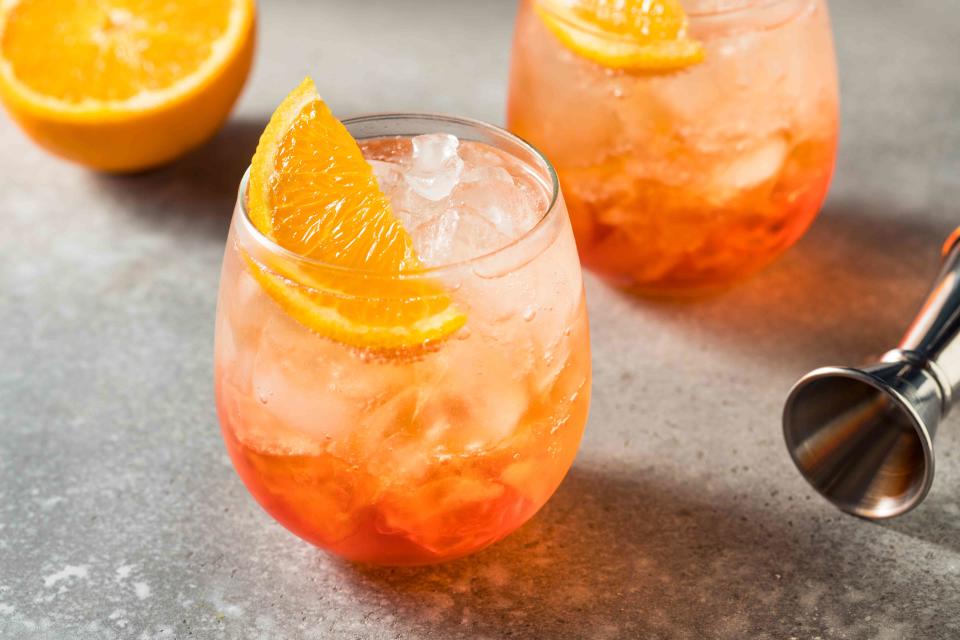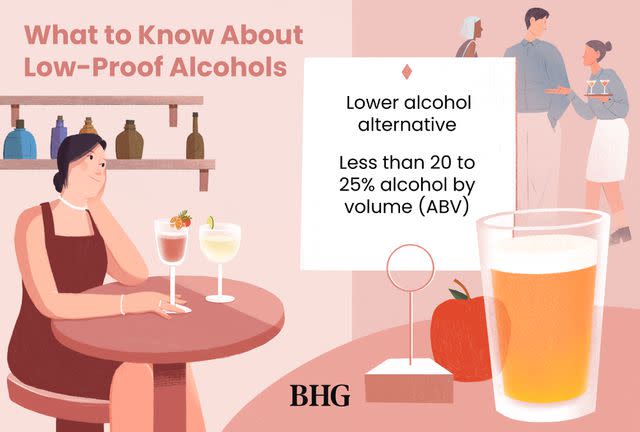Why More and More People Are Sticking to Low-Proof Alcohols
Whether you’re on a health kick or you’re just trying to avoid a hangover, low-proof alcohols might be a savvy addition to your night out.

Non-alcoholic beer, wine, and liquor have been staples for years for those who are sober, sober-curious, pregnant, or even just want a night off from drinking. But for those who still love to indulge in a buzzy beverage now and again, the latest and greatest alcohol trend has emerged: low-proof alcohols and low-proof cocktails. Why is this new option catching the eye of so many, and how can you make a low-proof cocktail at home? Here’s everything you need to know.
Related: Diet Cokagne Is the Low-Alcohol Cocktail People Can’t Stop Talking About

BHG / Julie Bang
What are low-proof alcohols?
While there’s no official definition, low-proof alcohols are typically identified as having less than 20 to 25% alcohol by volume (ABV). The term “proof” in the U.S. equates to twice the ABV, so in this case, low-proof alcohol would be anywhere under 40 to 50 proof. Typical spirits like vodka, gin, whiskey, tequila, brandy, and rum all measure in at about 40% ABV or higher, whereas an aperitif or cordial will measure in just under 25%. And some of the most standard favorites—including wine, beer, hard ciders, and hard seltzers—all meet the low-proof criteria, being well under 20% ABV.
Whether you’re partaking in a night out but still want to be productive the next day, you’re a health-conscious social drinker, or you have a solo cocktail-and-chill night planned, there are plenty of reasons to look for lower-alcohol beverage alternatives.
Related: How Mocktails Are Driving the Sober Curious Movement, in Dry January and Beyond
Given this info, the low-alcohol trend really speaks to low-proof, liquor-based beverages. Some low-proof options are made using wine or aperitifs—think a spritzer, or the famous Negroni Sbagliato (with prosecco in it). Certain bartenders will deem a cocktail low-proof if it only contains low-proof ingredients, while others have made their own rules.
Atlanta Magazine highlighted a group of local bartenders calling their low-proof cocktails "suppressors," referring to their role in suppressing alcohol content. In their signature low-proof cocktails, they don’t use any ingredient with an ABV higher than 25%, taking many liquors off the table.
Drew Lazor, author of Session Cocktails: Low-Alcohol Drinks for Any Occasion, defines his “session cocktails” as those containing no more than ¾ ounce (half a serving) of a high-proof spirit that contains 40% ABV or more. The name came to be because Lazor deemed these drinks “sessionable"—most people can have more than one of drinks and not feel like they've been hit by a ton of bricks in the morning.
Other bartenders choose to line cocktail glasses with a high-proof liquor by swishing around a small amount before pouring in the lower-proof cocktail. This gives sippers the essence of high-proof liquor with the benefits of a low-proof crafted concoction.
Alcohol brands, also inspired by this trend, are bringing lower-proof spirits to the market: products like BODY, a 30% ABV vodka; Sloe Gin, a gin alternative measuring in at 29% ABV; and Chareau, a brandy alternative with 25% ABV. However, with Alcohol and Tobacco Tax and Trade Bureau (TTB) alcohol labeling regulations, these beverages can’t legally be called vodka, gin, or brandy. Despite these bureaucratic hiccups, consumers can still get a sense of what to expect from these innovative alternatives.
Bringing Low-Proof Alcohols Into Your Life
Opting for low-proof cocktails is a great practice to integrate into both your personal and social life. Whether that looks like stocking up on some aperitifs like Aperol and Campari, simply adding less alcohol to your go-to cocktail order, or investing in some of the latest low-proof liquor substitutes hitting the market, there’s no shortage of options.
While this trend is in its infancy, and some purists scoff at the low-proof alternatives’ flavor and texture, there’s a lot of potential here for those who love a happy hour or a nightcap, but want to do so with more moderation.
For more Better Homes & Gardens news, make sure to sign up for our newsletter!
Read the original article on Better Homes & Gardens.

